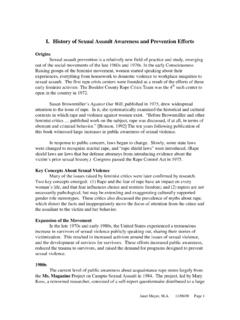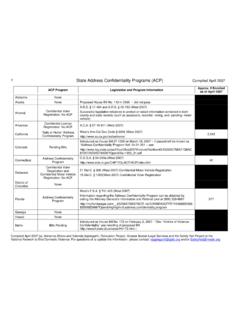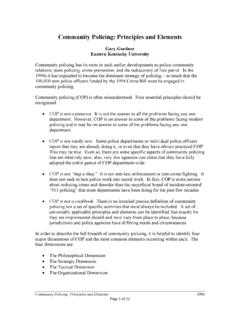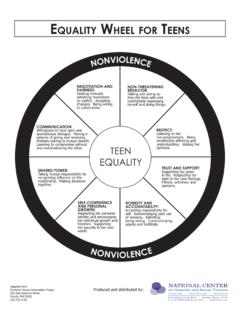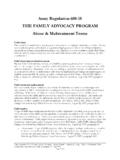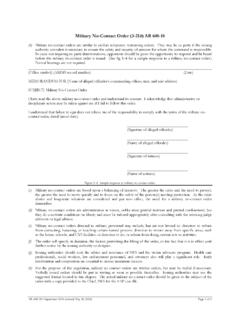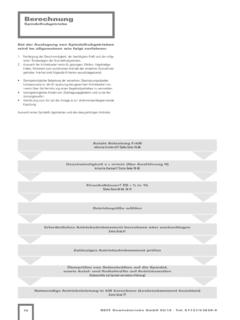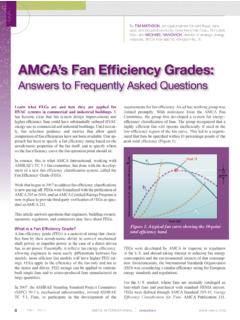Transcription of Toward a Fuller Conception of Machismo
1 Toward a Fuller Conception of Machismo : Development of a TraditionalMachismo and Caballerismo ScaleG. Miguel ArciniegaArizona State UniversityThomas C. AndersonChicago, IllinoisZoila G. Tovar-Blank and Terence J. G. TraceyArizona State UniversityMachismo is an important concept describing men s behavior in Mexican culture, yet it is not well-defined. Most conceptions of Machismo focus on a restricted, negative view of hypermasculinity. Theauthors posit that a Fuller Conception consists of 2 parts: traditional Machismo and caballerismo, whichis a focus on emotional connectedness. The authors developed a scale to measure these dimensions andfound support for these 2 independent factors in 2 separate studies of Mexican American men.
2 TraditionalMachismo was related to aggression and antisocial behavior, greater levels of alexithymia, and morewishful thinking as a coping mechanism. Caballerismo was positively associated with affiliation, ethnicidentity, and problem-solving coping. Traditional Machismo was also associated with less education,whereas there were no differences across education level on Caballerismo scores. These results supportthe more complete, two-dimensional representation of : Machismo , male gender roles, Mexican AmericanAlthough Machismo is a term that has been bandied about inpopular culture and has been the subject of many academic andliterary articles, it has continued to defy a clear definitional de-scription.
3 Machismo vaguely refers to a standard of behaviorexhibited by men in Mexican culture. Some definitions are Themasculine force, which to one degree or another drives all mas-culine behavior (Andrade, 1992, p. 34), An ethos comprised ofbehaviors prized and expected of men in Latin American coun-tries (Panitz, McConchie, Sauber, & Fonseca, 1983, p. 32), and Mexican men s manifestation of perceived male characteristics,both positive and negative (Arciniega, Tovar-Gamero, & Sand,2004).In the majority of the popular literature, the term has continuedto be associated with the negative characteristics of sexism, chau-vinism, and hypermasculinity (Anders, 1993; Ingoldsby, 1991;Mosher & Tompkins, 1988).
4 Writers, such as Imhof (1979), de-scribed macho men as violent, rude, womanizing, and prone toalcoholism. Anders (1993) cited authors from various disciplineswho typified macho men as incompetent, as domineering throughintimidation, and as seducing and controlling literature, with few exceptions, has also endorsedthe concept of Machismo as having only negative characteristics,such as violent, aggressive, and sexualized behaviors (Beaver,Gold, & Prisco, 1992; Mosher & Sirkin, 1984), or as beingassociated with violence and heavy drinking (Alaniz, 1996; neff ,Prihoda, & Hoppe, 1991). Mayo and Resnick (1996) pointed outthat Machismo among Latino men typically involves the domina-tion of women, who are viewed as responsible for raising childrenand serving men.
5 Researchers who have looked at Machismo as apsychological construct almost uniformly characterized machismoas something aggressive and hypermasculine. Indeed, research onmachismo is frequently tautological; a common occurrence inresearch is to assume Machismo is violent and aggressive and tocreate a measure that measures Machismo as defined by aggressiveacts or , some scholars have argued against this negative con-ception of Machismo as being too restrictive ( , Casas, Wagen-heim, Banchero, & Mendoza-Romero, 1994; Felix-Ortiz, Abreu,Briano, & Bowen, 2001; Mirande , 1988, 1997; Penalosa, 1968;Ramos, 1979; Rodriguez, 1996).
6 In a survey of Latino men,Mirande (1988) found that 52% described Machismo as a largelynegative construct, 12% described it as a neutral concept, and 35%described it as a source of pride and honor. The results of this studypoint out that the positive aspects of male behavior are frequentlyneglected, and thus, an inadequate picture of Mexican Americanmale behavior is (1997) noted that the problems of past research werethe focus on only negative aspects of Machismo . Mirande (1988)began looking at Machismo qualitatively by reviewing stories,myths, and organized interviews. Mirande (1997) used focusgroups and historical examination of the evolution of Machismo inMexico to develop his Mirande s Sex Role Inventory (Mirande ,1997).
7 Mirande s Sex Role Inventory used both positive andnegative statements in an attempt to capture the diverse meaningsattributed to Machismo . Mirande (1997) assumed that there wereG. Miguel Arciniega, Zoila G. Tovar-Blank, and Terence J. G. Tracey,Counseling Psychology Program, Division of Psychology in Education,College of Education, Arizona State University; Thomas C. Anderson,Independent Practice, Chicago, concerning this article should be addressed to Arciniega, 302 Payne Hall, MC 0611, Arizona State University,Tempe, AZ 85287-0611. E-mail: of Counseling PsychologyCopyright 2008 by the American Psychological Association2008, Vol.
8 55, No. 1, 19 330022-0167/08/$ DOI: masculinities being composed of positive and negativeelements ( , traditionalism, toughness, and sensitivity).Mirande s view of Machismo is one that is more encompassingthan earlier work on Machismo because this view includes morethan just negative aspects of the field of psychology and sociology, the growing trendis Toward a more bidimensional assessment of Machismo . Tovarying degrees, Machismo in the Mexican and the MexicanAmerican community is being defined as a construct that is bothpositive and negative (Casas et al., 1994; Mirande , 1997; neff ,2001). Various researchers concerned with the balanced represen-tation of Machismo within Mexican and Mexican American cul-tures have often pointed out the positive characteristics consistentwith Machismo : nurturance, protection of the family and its honor,dignity, wisdom, hard work, responsibility, spirituality, and emo-tional connectedness (Casas et al.)
9 , 1994; Mirande , 1988, 1997;Ramos, 1979).Positive descriptors of Machismo appear to resemble qualitiesassociated with the wordcaballerismo. Caballerismo originates inthe Spanish word for horse and horseman caballoandcaballero,respectively (Caballero, 2003). Caballerismo refers to a code ofmasculine chivalry, an English term that also stems from theoriginal Latin rootcaballus. Like the English chivalric code,caballerismo developed out of a medieval sociohistorical classsystem in which people of wealth and status owned horses fortransportation and other forms of horsepower. Thus,caballeroreferred to a land-owning Spanish gentleman of high station whowas master of estates and/or ranches ( ,haciendas).
10 ComparableEnglish terms arecavalierandknight. Over time and centuries ofusage on both sides of the Atlantic,caballeroevolved to signify aSpanish gentleman with proper, respectful manners, living by anethical code of chivalry ( , caballerismo; C. Candelaria, personalcommunication, July 13, 2007).Moreover, if we look back to the origins of the folklore ofcaballerismo, we would have to go back to the 16th centurySpanish romances of chivalry, such as Miguel de Cervantes and hisnovelDon Quixote. The character of Don Quixote is depicted as acaballero who is a noble and humble hero, righting the wrongs andseeking justice for the people.
